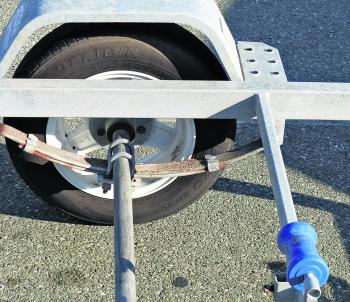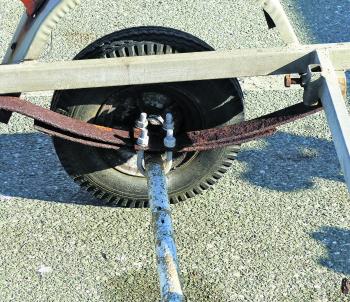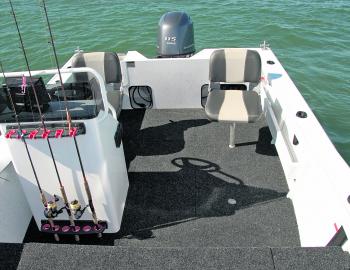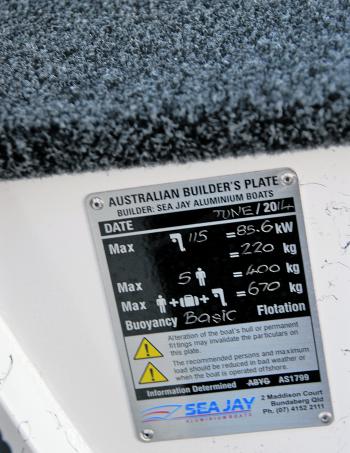A conundrum that usually confronts someone buying a boat is whether to buy new or used.
Let’s face it, new is lovely – clean and polished, everything spick and span, but cost is the major factor with the very slight chance of some component or feature of the new rig not quite working as it should.
On the latter point, boats are not like motor cars, which are mass produced by the millions to a rigid schedule of robotic assembly, which ensures that things rarely differ thanks to rigid quality control. With boats there are few variables in the actual construction of a hull, but once into the fit out and finish, the fun commences. Engine ratings vary for a start, so a hull can be under-powered, adequately powered or over powered, the latter being a real cause for concern. Selected fittings, equipment and other items are all manually fitted by fellow humans, so it naturally follows that sometimes there’s a mistake or mismatch in components.
I was once reviewing a brand new craft – a massive plate alloy rig – where the trim tab controls were reversed causing a very bad situation once we started to move quickly, and was only solved by a very slow return to the ramp in total silence. While that’s a very extreme example, there’s no denying that teething troubles can occur with brand new rigs.
In contrast, the situation with a used craft is different, all bugs are generally ironed out and it’s a going concern. With those matters in mind, a second hand boat might make a lot of sense, especially if it’s with an original owner, or in a reputable dealer’s yard with full history and mechanical background on display. Even a rig that has had a couple of owners and still looks to be in really good condition is worth some consideration, even if all precautionary checks come through with flying colours.
A suitable craft from a well-known manufacturer is spotted in a well-known dealer’s yard and it’s within the proposed price range.
It’s important that the boat is on a trailer that, while there might be some discoloration of the springs and axle or perhaps even some dulling of the galvanizing here and there, is otherwise in good nick. Remember that the trailer must have brakes if the total weight of hull, trailer, engine and full fuel load is over 750kg.
Trailer considerations aside, the boat should be exactly the type you had in mind in that it will fulfil requirements in regard to anticipated use, crew capacity, interior storage and comfort levels, and the engine’s within manufacturer’s limits, as set out on the builder’s plate which will outline year of manufacture along with passenger ratings. If a near maximum crew capacity is likely most of the time, it’s probably best if the engine is towards the upper limits of power rather than lower, or the rig might struggle to perform well.
Taking interest further, the dealer will explain the craft’s history and draw your attention to the extra components or features that have upgraded the rig from standard. A mechanic’s inspection report of the engine will show the engine computer’s hours, list any components they replaced such as oil within a four stroke engine, a water pump impeller or spark plugs along with the fuel filter.
An engine compression check can be provided and it’s important that the compression readings of all cylinders are within 10% of each other. If a factory warranty still covers the hull and/or engine, such warranty is transferable and the dealer can explain how to facilitate this procedure.
Next will be a test run and the dealer will easily arrange this very important part of the procedure. If all goes well, the transaction is finalised, and with the registration transferred the rig’s on its way home.
A dealer needs to cover staff wages, maintenance of financial transactions, insurance and a host of other things, all of which must unavoidably add cost to any craft in the yard. A private sale avoids this kind of overhead and, as we are all dollar driven, it follows that a lot of purchases are directly from a private owner rather than a dealer.
In truth, many boats are sold this way and if the buyer goes about things correctly, everyone wins. Remember though, it’s buyer beware! Due diligence does apply to boats – the same as other major purchases. Peace of mind comes from a standard REV check – via the craft’s Hull Identification Number – which can reveal if it’s free and unencumbered.
Again, first impressions are very important. The boat for sale should look clean, tidy, and well-presented and if it does, it’s well worth considering. Understand though, that many of the things I mentioned previously in regard to purchase from a dealer still make perfect sense, although some of the more involved checks and investigations, that of the engine specifically, will require arrangement by the buyer and should be sorted beforehand.
When surveying the hull’s condition, a well maintained fibreglass hull should still look quite shiny with metal fittings, clean and corrosion free, thanks to being kept washed and polished. Likewise, any bimini or other frame work should be corrosion free while fabric, clears, and the like are free of mildew or marks, which are both a sure sign of some neglect. A walk around inside the hull should not reveal any saggy or soft areas on the floor. There’s something wrong there if it is!
A good look under the hull might reveal some minor scuff marks or longitudinal scratches, which are very hard to avoid on glass rigs, and tell only of use rather than outright neglect or abuse. Deep indentations or dings are another matter and cause for second thoughts, especially if the gel coat is deeply scarred, which can lead to water absorption and deterioration of the fibreglass.
Fibreglass, however, is highly repairable, so if there is any sign of repairs, full disclosure should set a buyer’s mind at rest.
A glance inside storage compartments such as those under the floor or under bunks or seats will be reassuring if such areas are totally clean, dry, and without any odour. The main advantage with fibreglass hulls pertains to the ride, which is usually superior, due to the enhanced shape, particularly in regard to larger off shore style rigs, than that of alloy. At the same time, glass hulls always require more care around the ramp and fixed obstacles to avoid damage. And, of course, they are not available in the small sizes that alloy rigs are.
Alloy hulls are a different proposition again. Alloy craft have come ahead in leaps and bounds in the last decade and many are fast approaching the ride quality of their glass rivals. In truth, most smaller trailerable alloy craft have a ride that is more than satisfactory for general fishing and boating pursuits. They are offered in both painted and unpainted styles, so there are pros and cons.
Unpainted alloy is designed to take on a dull appearance over time, and this minor oxidisation actually protects the hull. Painted hulls look great but can quickly show up areas of accidental contact. Remember that scratches, scuff marks and the like are all signs of use, rather than outright neglect. Neglect will involve large areas of salt build up, corrosion under things that can be lifted up, damp or smelly areas within the anchor well or within any storage hatches. Big dings or dents under the hull along with gouges along the keel proper also are indicative of a very hard working life.
Electrolysis is a factor with alloy hulls and shows up as powdery residue around add-on fittings, which, if made of disimilar material to the alloy hull, can cause electrolysis. Note there might be corrosion or severe bubbling of paint work in a painted craft, or some powdery residue near fittings in an unpainted craft.
Consider this though. Alloy hulls, even if only a few years old, might well display tiny areas of random bubbling of paint here and there, the size of a five cent piece perhaps. When of a minor nature, these should be no real cause of concern. On the other hand, large areas of such corrosion are indicative of neglect and are a red flag to a buyer. Something to remember is if you do buy a used alloy craft and the floor is removable, lift it up once home and look for any loose or foreign metallic objects down there, as these will certainly cause electrolysis down the track.
Boat engines work very hard in an extremely hostile environment and demand some TLC to maintain top performance. So with the chosen hull looking good and the trailer up to scratch, it’s time to assess the engine. Few buyers have the nous to really assess an engine other than look under the cowl, check on how easy it starts, give the nod to a steady stream of water from the tell tale and to ensure the year of manufacture matches the hull’s.
To provide more involved engine assessment and general condition, there are plenty of properly certified mobile marine mechanics able to do just that and provide a written report for consideration. It’s a wise move to arrange a mechanic’s inspection prior to finalizing a purchase, and if the mechanic specialises in the brand of motor involved, so much the better.
An experienced mechanic can also run an eye over the whole rig and make a generalized report on its overall condition. Also, if an hour meter is fitted, it’s always interesting to have the mechanic compare actual hours (via a dedicated computer) with those of the meter. However, if the seller seems uncooperative for a mobile mechanic to be involved, the upshot is obvious, and it’s time to look at another boat.
There are a few small things about the engine worth considering as well. The overall cleanliness under the cowl is indicative of regular servicing and ample TLC from the owner. Tell tale indications of salt residue (powder showing) are pointing to a leaking gasket. One area where it certainly is good to see a bit of grease is around the engine’s pivot point, near where it’s bolted or clamped onto the transom. There are grease nipples there and if the owner has kept the engine in good nick, it’s nice to see a bit of grease showing.
Unpainted areas on the bottom of the skeg and removal of paint from the prop reveal plenty of sand contact. Note that the engine should start within 6-10 revolutions when the key is turned, run smoothly, and should snick in and out of gear with only a small jar.
All wiring, switches and links to important accessories or functions such as lights, bilge pumps, bait tank plumbing and marine radios where fitted are expected to be fully functional in any boat, new or used.
It’s fair to say that items such as nav aids, sounders, in-built battery chargers or sound systems are only a possibility and really not to be expected as part of a sale. If provided, they can be fairly regarded as a bonus and whether sounders and nav aids are working perfectly or otherwise will be debatable, perhaps, until the craft is off its trailer. That aside, additional electronics are still worthy of consideration in any deal.
A boat is a major purchase in many instances, so choosing correctly and wisely is very important from the outset to ensure money is not ill spent. Whether from a boat yard or a private sale, a test run is mandatory to finally assess performance and the craft’s suitability for intended use. Ease of removal from, and entry back onto, the trailer is quite worth noting as well.
Overall, it’s very important to make the right choice, as passengers in the boat are going to remember with great detail exactly what happened if things go pear-shaped later. If this happens, it may be hard to coerce them into another fun time on the water.
Reads: 2740
New boats are great! Everything’s shiny and brand spankers like everything on this TABS I reviewed, but some serious dollars can be saved if you can find the right used craft.

One area where a bit of grease should put in an appearance is the engine’s pivot point at the transom.

What an engine should look like: no leaks in sight and no excessive oil or grease.

Launching most small craft will see the springs in the water, hence the minor discolouration, but if the rest of the trailer looks OK, there’s no real cause for abandonment of further enquiries.

When the trailer shows this sort of neglect, the rest of the craft likely won’t have been given too much TLC either.

Big sounders are a bonus in any second hand craft, but should not be regarded as standard equipment. The same goes with sound systems.

Rod racks, rod holders and other useful equipment installed in a used rig will always add both interest and perhaps value to an intended sale.

The builder’s plate reveals all. It’s well worth checking if the engine and hull match in age, and that the proposed capacity is correct.




